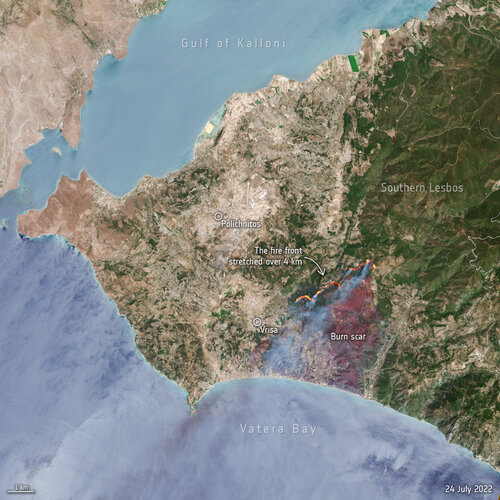
Copernical Team
Eutelsat, OneWeb plan to merge
 French and British satellite operators Eutelsat and OneWeb on Tuesday announced plans to merge and create a "global champion" in the fast-growing broadband internet market, rivalling US giants such as Elon Musk's Starlink.
Eutelsat and OneWeb said in a joint statement they had signed a memorandum of understanding to join forces to become "a leading global player in connectivity... in an all-
French and British satellite operators Eutelsat and OneWeb on Tuesday announced plans to merge and create a "global champion" in the fast-growing broadband internet market, rivalling US giants such as Elon Musk's Starlink.
Eutelsat and OneWeb said in a joint statement they had signed a memorandum of understanding to join forces to become "a leading global player in connectivity... in an all- Preparing for the World's biggest radio telescope
 An international team of researchers has demonstrated that the Square Kilometre Array Observatory (SKAO) is capable of detecting radio emissions from normal spiral galaxies in the early universe. The SKAO, whose construction began this year, will soon be the largest radio telescope in the world. The astronomers, who are part of the SKAO's "Extragalactic Continuum" working group, are looking for
An international team of researchers has demonstrated that the Square Kilometre Array Observatory (SKAO) is capable of detecting radio emissions from normal spiral galaxies in the early universe. The SKAO, whose construction began this year, will soon be the largest radio telescope in the world. The astronomers, who are part of the SKAO's "Extragalactic Continuum" working group, are looking for Russia to quit International Space Station 'after 2024'
 Russia has decided to quit the International Space Station "after 2024", the newly-appointed chief of Moscow's space agency told President Vladimir Putin on Tuesday.
"Of course, we will fulfil all our obligations to our partners, but the decision to leave this station after 2024 has been made," Roscosmos chief Yury Borisov told Putin in comments released by the Kremlin.
Russia has decided to quit the International Space Station "after 2024", the newly-appointed chief of Moscow's space agency told President Vladimir Putin on Tuesday.
"Of course, we will fulfil all our obligations to our partners, but the decision to leave this station after 2024 has been made," Roscosmos chief Yury Borisov told Putin in comments released by the Kremlin. ESA showcases its space ambition at Farnborough airshow

ESA’s efforts to ensure European citizens reap the benefits of space have been highlighted at a global aerospace event held in the UK.
NASA wants your help designing a starshade to observe exoplanets

The field of exoplanet study has come a long way in recent decades. To date, 5,063 exoplanets have been confirmed in 3,794 systems beyond our own, with another 8,819 candidates awaiting confirmation. In the coming years, tens of thousands of more planets are expected to be found, thanks to next-generation observatories. The ultimate goal in this search is to find planets that are "Earth-like," meaning they have a good chance of supporting life. This is no easy task, as rocky planets located within their parent star's habitable zones (HZs) tend to orbit closely, making them harder to see.
To make this process easier, NASA is designing a hybrid observatory consisting of a "Starshade" that will block out a star's light so that a ground-based telescope can directly image planets orbiting it.
Explosive volcanic eruption produced rare mineral on Mars

Planetary scientists from Rice University, NASA's Johnson Space Center and the California Institute of Technology have an answer to a mystery that's puzzled the Mars research community since NASA's Curiosity rover discovered a mineral called tridymite in Gale Crater in 2016.
Tridymite is a high-temperature, low-pressure form of quartz that is extremely rare on Earth, and it wasn't immediately clear how a concentrated chunk of it ended up in the crater. Gale Crater was chosen as Curiosity's landing site due to the likelihood that it once held liquid water, and Curiosity found evidence that confirmed Gale Crater was a lake as recently as 1 billion years ago.
Greece battles wildfires on Lesbos island
 Image:
Hundreds of residents and tourists have been evacuated from the Greek island of Lesbos after a wildfire broke out on the morning of 23 July. This image, captured by Sentinel-2, shows the active fire front which stretches for more than four km.
Image:
Hundreds of residents and tourists have been evacuated from the Greek island of Lesbos after a wildfire broke out on the morning of 23 July. This image, captured by Sentinel-2, shows the active fire front which stretches for more than four km. Sumitomo invests in TAE Technologies for Fusion Reactor development
 Sumitomo Corporation of Americas ("SCOA") has announced its investment in TAE Technologies ("TAE"), a fusion power company and world leader in hydrogen-boron fusion research. The investment will help fund the construction of TAE's next research reactor, "Copernicus" and accelerate SCOA's implementation of fusion power in Japan and Asia as part of the company's strategy to help realize a carbon-n
Sumitomo Corporation of Americas ("SCOA") has announced its investment in TAE Technologies ("TAE"), a fusion power company and world leader in hydrogen-boron fusion research. The investment will help fund the construction of TAE's next research reactor, "Copernicus" and accelerate SCOA's implementation of fusion power in Japan and Asia as part of the company's strategy to help realize a carbon-n Maxar's hi-res Vivid Basemaps enhances Esri ArcGIS Living Atlas of the World
 Maxar Technologies (NYSE:MAXR) (TSX:MAXR), provider of comprehensive space solutions and secure, precise, geospatial intelligence, has announced that Esri, the global leader in geographic systems (GIS) and location intelligence, will enhance the World Imagery layer with higher resolution Maxar Vivid basemaps in the Living Atlas.
With the new, multiyear agreement, Esri will use Maxar's Vivi
Maxar Technologies (NYSE:MAXR) (TSX:MAXR), provider of comprehensive space solutions and secure, precise, geospatial intelligence, has announced that Esri, the global leader in geographic systems (GIS) and location intelligence, will enhance the World Imagery layer with higher resolution Maxar Vivid basemaps in the Living Atlas.
With the new, multiyear agreement, Esri will use Maxar's Vivi China's space station expanding nation technology base
 The Wentian space lab will help to greatly advance scientific research and the development of technology in China, providing a unique platform for experiments that are difficult or impossible to be done on Earth, a senior scientist said.
Zhang Wei, director of the Chinese Academy of Sciences' Technology and Engineering Center for Space Utilization, said on Sunday in Wenchang, Hainan provin
The Wentian space lab will help to greatly advance scientific research and the development of technology in China, providing a unique platform for experiments that are difficult or impossible to be done on Earth, a senior scientist said.
Zhang Wei, director of the Chinese Academy of Sciences' Technology and Engineering Center for Space Utilization, said on Sunday in Wenchang, Hainan provin 































